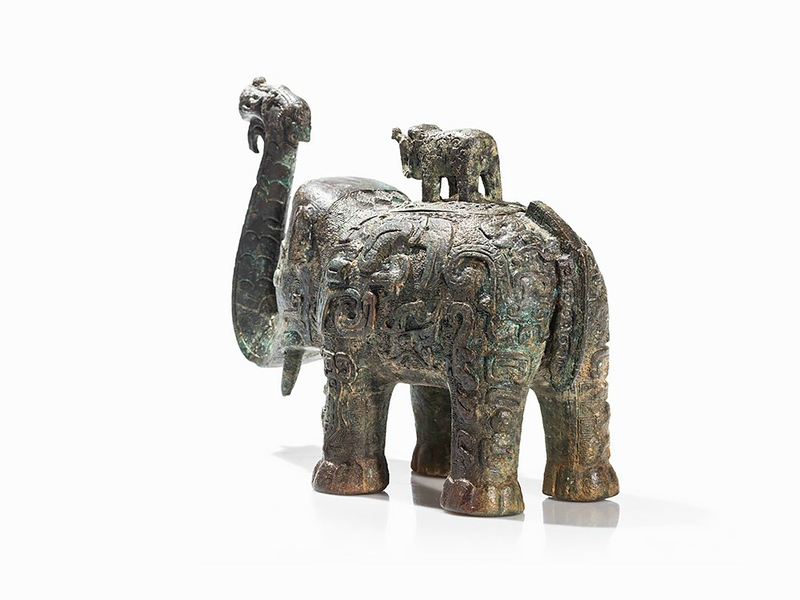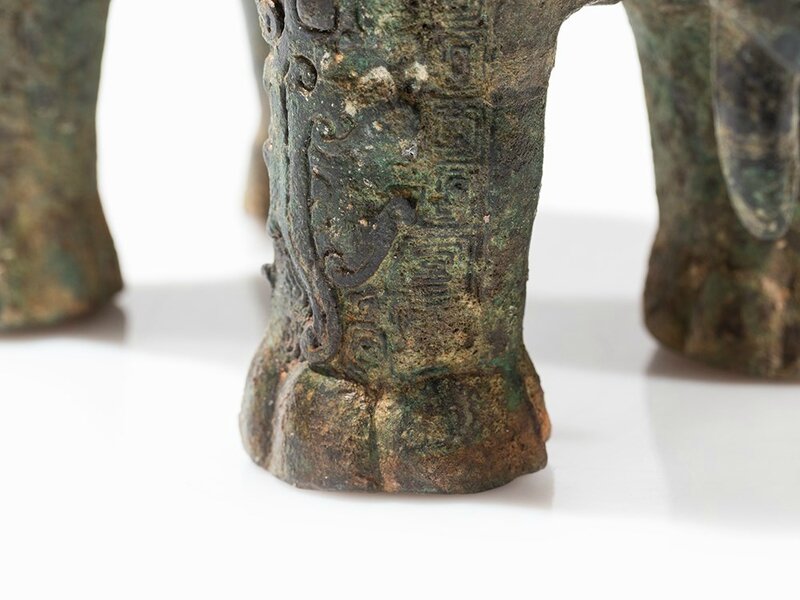Bronze Elephant-shaped, zun, Shang Dynasty (1766-1028 BC)
Bronze Elephant-shaped, zun, Shang Dynasty (1766-1028 BC). Estimate 30 000 € / 39 000 €. Photo Auctionata AG
Archaic zun vessel in the shape of an elephant - Standing on four legs - Richly decorated body - On a leiwen ground an archaic tendril pattern, masks, dragons and phoenixes are visible in relief - The trunk is raised and serves as spout - The back is surmounted by a lid with a smaller elephant - A six-character inscription is visible on the belly - The surface with a black-green lacquer patina - With a base (later) - Dimensions: 24 x 30 cm - Weight: c. 3100 grams - Good condition consistent with age
Provenance: Property of a French noble man, in the family collection since at least 1967. Listed in the collection inventory from 1967 (see scan in the photo gallery).
Notes: This vessel in the shape an elephant is one of the few known examples. Cf. an almost identical example in the Hunan Provincial Museum in China (accession no. hunan18) illustrated in Treasures from the Bronze Age of China, An Exhibition from the People’s Republic of China, exhib.cat., New York 1980, pp. 82f. Similar ZUN are in the collection of the Freer and Sackler Galleries, Smithsonian Institution, Washington D.C. (accession no. F1936.6a-b) and in the Musée Guimet in Paris (accession no. EO 1545). Cf. Smithsonian Institution (ed.), The Freer Chinese Bronzes, vol. 1, Washington 1967, pp. 228-231.
ZUN
The ZUN is a vessel type which has the shape of a large, wide cup with a bulbous center part and a wide mouth and foot. The ZUN is reminiscent in its shape to a wide and smaller KU and vessels in the form of various animals are also known as ZUN.
Elephant
The elephant is found throughout in Asian and is already mentioned in the 3rd century in Chinese literature. In the Ming dynasty elephants were part of important imperial celebrations. The elephant is often the mount of a hero and a symbol of prudence, wisdom and strength. Riding an elephant means happiness, which is often represented by a child on the back of the elephant. The depiction of an elephant with a vase on the back is a symbol of peace and serenity.
AUCTIONATA AG, 10719 BERLIN. Sculptures et Bronze d'Asie provenant de la Collection D'une Noble Famille Europééenne, le 20 Juin 2015 à 18h00

/https%3A%2F%2Fprofilepics.canalblog.com%2Fprofilepics%2F1%2F0%2F100183.jpg)
/https%3A%2F%2Fstorage.canalblog.com%2F03%2F02%2F119589%2F96711876_o.jpg)
/https%3A%2F%2Fstorage.canalblog.com%2F11%2F31%2F119589%2F94773502_o.jpg)
/https%3A%2F%2Fstorage.canalblog.com%2F20%2F83%2F119589%2F94772815_o.jpg)
/https%3A%2F%2Fstorage.canalblog.com%2F26%2F72%2F119589%2F75604929_o.jpg)
/https%3A%2F%2Fstorage.canalblog.com%2F59%2F60%2F119589%2F26458628_o.jpg)





















/image%2F1371349%2F20240406%2Fob_b23648_434058570-1644317966338216-88086167391.jpg)
/image%2F1371349%2F20240403%2Fob_6d5ae7_dp-28103-001.jpg)
/image%2F1371349%2F20240229%2Fob_8f31f9_431013694-1625286614908018-33034430839.jpg)
/http%3A%2F%2Fstorage.canalblog.com%2F79%2F20%2F119589%2F129837997_o.jpg)